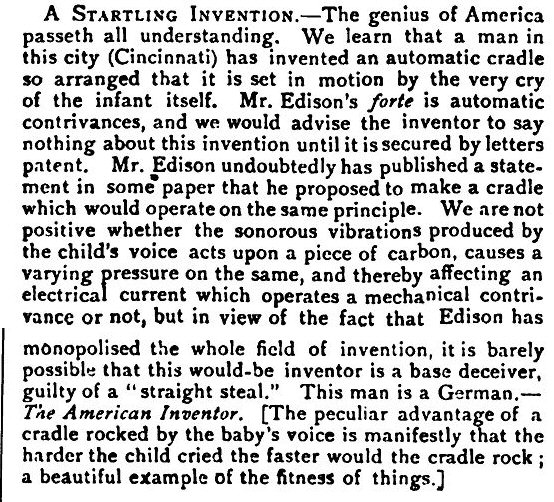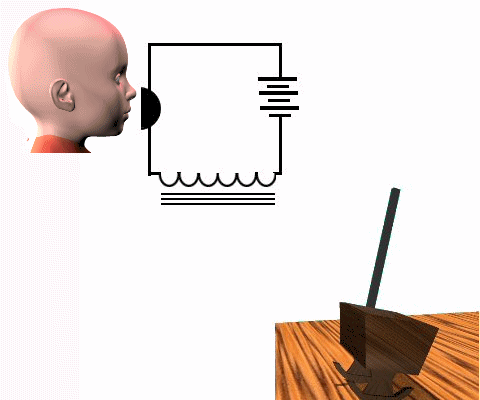Sunday, April 14, 2013
Tickle me Alva
Think voice-driven toys are new? Nope. Think monopolistic patent-pooling was invented by Steve Jobs? Nope.
From 1878:
 The telephone and microphone were new in 1878, spawning all sorts of useful and useless variants. Clearly old Tom already had a talent for monopolizing patents!
Though the circuit isn't given (and the writer doesn't understand the carbon microphone) it's easy enough to imagine how it must have looked. A carbon mic in series with a solenoid. When sound comes in, the mic is compressed, resistance goes down, current increases, and the solenoid somehow pulls the cradle. (When the wind blows, the cradle will rock....)
The telephone and microphone were new in 1878, spawning all sorts of useful and useless variants. Clearly old Tom already had a talent for monopolizing patents!
Though the circuit isn't given (and the writer doesn't understand the carbon microphone) it's easy enough to imagine how it must have looked. A carbon mic in series with a solenoid. When sound comes in, the mic is compressed, resistance goes down, current increases, and the solenoid somehow pulls the cradle. (When the wind blows, the cradle will rock....)
 Would it work? If the human voice were an ideal sine wave, and if carbon microphones were ideal pressure-controlled resistors, it wouldn't work. The compressions and rarefactions of sound would be equal in intensity, and the microphone's decreases and increases would also be equal. Net result: an attempt to move the cradle back and forth at more than 500 cycles per second. Obviously no cradle could keep up with that. There might be a very slight buzz, which wouldn't be sensed by the baby. He's busy screeching anyway.
But: In 1878 mixing sound with electricity was a brand new idea, and the carbon mic was a primitive design. It would have been an extreme low-pass filter... AND speech is very far from an ideal sine wave. It's always asymmetrical, usually with more summed-up energy on the compression side. A low-passed representation of the speech wave would thus be a net push on the microphone. So each 'word' of the crying might give a single pull to the cradle, which would then fall back when the baby inhaled for the next screech. Yes, it could have worked.
Would it work? If the human voice were an ideal sine wave, and if carbon microphones were ideal pressure-controlled resistors, it wouldn't work. The compressions and rarefactions of sound would be equal in intensity, and the microphone's decreases and increases would also be equal. Net result: an attempt to move the cradle back and forth at more than 500 cycles per second. Obviously no cradle could keep up with that. There might be a very slight buzz, which wouldn't be sensed by the baby. He's busy screeching anyway.
But: In 1878 mixing sound with electricity was a brand new idea, and the carbon mic was a primitive design. It would have been an extreme low-pass filter... AND speech is very far from an ideal sine wave. It's always asymmetrical, usually with more summed-up energy on the compression side. A low-passed representation of the speech wave would thus be a net push on the microphone. So each 'word' of the crying might give a single pull to the cradle, which would then fall back when the baby inhaled for the next screech. Yes, it could have worked.
 The telephone and microphone were new in 1878, spawning all sorts of useful and useless variants. Clearly old Tom already had a talent for monopolizing patents!
Though the circuit isn't given (and the writer doesn't understand the carbon microphone) it's easy enough to imagine how it must have looked. A carbon mic in series with a solenoid. When sound comes in, the mic is compressed, resistance goes down, current increases, and the solenoid somehow pulls the cradle. (When the wind blows, the cradle will rock....)
The telephone and microphone were new in 1878, spawning all sorts of useful and useless variants. Clearly old Tom already had a talent for monopolizing patents!
Though the circuit isn't given (and the writer doesn't understand the carbon microphone) it's easy enough to imagine how it must have looked. A carbon mic in series with a solenoid. When sound comes in, the mic is compressed, resistance goes down, current increases, and the solenoid somehow pulls the cradle. (When the wind blows, the cradle will rock....)
 Would it work? If the human voice were an ideal sine wave, and if carbon microphones were ideal pressure-controlled resistors, it wouldn't work. The compressions and rarefactions of sound would be equal in intensity, and the microphone's decreases and increases would also be equal. Net result: an attempt to move the cradle back and forth at more than 500 cycles per second. Obviously no cradle could keep up with that. There might be a very slight buzz, which wouldn't be sensed by the baby. He's busy screeching anyway.
But: In 1878 mixing sound with electricity was a brand new idea, and the carbon mic was a primitive design. It would have been an extreme low-pass filter... AND speech is very far from an ideal sine wave. It's always asymmetrical, usually with more summed-up energy on the compression side. A low-passed representation of the speech wave would thus be a net push on the microphone. So each 'word' of the crying might give a single pull to the cradle, which would then fall back when the baby inhaled for the next screech. Yes, it could have worked.
Would it work? If the human voice were an ideal sine wave, and if carbon microphones were ideal pressure-controlled resistors, it wouldn't work. The compressions and rarefactions of sound would be equal in intensity, and the microphone's decreases and increases would also be equal. Net result: an attempt to move the cradle back and forth at more than 500 cycles per second. Obviously no cradle could keep up with that. There might be a very slight buzz, which wouldn't be sensed by the baby. He's busy screeching anyway.
But: In 1878 mixing sound with electricity was a brand new idea, and the carbon mic was a primitive design. It would have been an extreme low-pass filter... AND speech is very far from an ideal sine wave. It's always asymmetrical, usually with more summed-up energy on the compression side. A low-passed representation of the speech wave would thus be a net push on the microphone. So each 'word' of the crying might give a single pull to the cradle, which would then fall back when the baby inhaled for the next screech. Yes, it could have worked.
